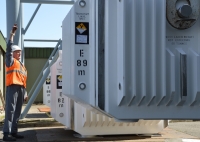Three innovative technologies to reduce the costs of treating and storing nuclear industry wastes are to receive funding in Britain, while a major decommissioning milestone is being celebrated at one of the country's first-generation sites.
 |
| Fewer than 160 used fuel flasks remain for Sizewell A (Image: Magnox) |
Engineering company Costain has announced that it has secured funding from the UK's government-founded innovation agency, the Technology Strategy Board, through an £18 million ($28 million) competition.
Co-funded by the UK's Department of Energy and Climate Change (DECC), the Engineering and Physical Science Research Council and the Nuclear Decommissioning Agency, the contest brings together so-called "experienced organisations" with small and medium enterprises and universities in order to develop the supply chain and encourage innovation.
The three projects will see Costain work with a range of UK organisations on technologies for intermediate-level waste (ILW) management, treatment of graphite waste and decontamination technology.
Costain will work with Tetronics International to develop a plasma waste vitrification system to reduce the volume and enhance the stability of intermediate-level radioactive waste. A second Costain project, led by decommissioning technology company Bradtec with the support of Studsvik, Hyder Consulting and the University of Manchester, will develop a system for the gasification of graphite from decommissioned reactors. Such a technology would significantly reduce the volume of graphite waste. The third project, in which Costain is working with Createc, will trial a system to measure the depth of contamination in structures. This, says Costain, will enable more effective targeting of decontamination measures and result in a reduction in the volume of material treated.
Defuelling milestone at Sizewell
Removal of fuel elements from the UK's shut-down Sizewell A plant has passed the half-way point. A total of 52,945 fuel elements need to be removed from the twin Magnox reactors at the site, which shut down in 2006 after 40 years of operation. After removal from the reactors, the used fuel is transported to the Sellafield site for reprocessing.
With a civil nuclear legacy comprising nuclear sites and facilities from the earliest nuclear research projects of the 1940s to the fleet of Magnox power reactors built from the 1950s to the 1970s, plus associated wastes and materials, the back-end of the nuclear fuel cycle is challenging for the UK nuclear industry. The funding was announced by UK business secretary Vince Cable, who said the UK was positioning itself to take advantage of the opportunities afforded by its work program. "Our strong research base will help develop exciting new technologies that can be commercialised here and then exported across the globe," said Cable.
Researched and written
by World Nuclear News




_18570.jpg)
_18938.jpg)
_33584.jpg)
_82983.jpg)





